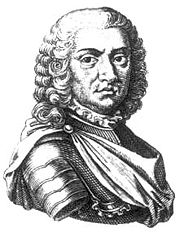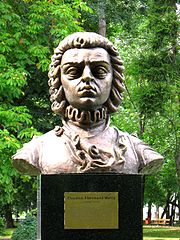
Florimund Mercy
Encyclopedia

De Mercy
The De Mercy family rose to increasing power during the Middle Ages in the region of what is now southern Belgium, Lorraine and Luxembourg.By the fifteenth century Jean de Mercy was lord of Clémarais ; in 1477, Roger de Mercy was appointed Captain and Provost of Longwy by Duke René II of Lorraine...
(1666, Longwy
Longwy
Longwy is a commune in the Meurthe-et-Moselle department in north-eastern France.The inhabitants are known as Longoviciens.-Economy:Longwy has historically been an industrial center of the Lorraine iron mining district. The town is known for its artistic glazed pottery.-History:Longwy initially...
– 1734, Parma
Parma
Parma is a city in the Italian region of Emilia-Romagna famous for its ham, its cheese, its architecture and the fine countryside around it. This is the home of the University of Parma, one of the oldest universities in the world....
) was an Imperial
Holy Roman Empire
The Holy Roman Empire was a realm that existed from 962 to 1806 in Central Europe.It was ruled by the Holy Roman Emperor. Its character changed during the Middle Ages and the Early Modern period, when the power of the emperor gradually weakened in favour of the princes...
field marshal
Field Marshal
Field Marshal is a military rank. Traditionally, it is the highest military rank in an army.-Etymology:The origin of the rank of field marshal dates to the early Middle Ages, originally meaning the keeper of the king's horses , from the time of the early Frankish kings.-Usage and hierarchical...
, born at Longwy
Longwy
Longwy is a commune in the Meurthe-et-Moselle department in north-eastern France.The inhabitants are known as Longoviciens.-Economy:Longwy has historically been an industrial center of the Lorraine iron mining district. The town is known for its artistic glazed pottery.-History:Longwy initially...
in Lorraine
Lorraine (province)
The Duchy of Upper Lorraine was an historical duchy roughly corresponding with the present-day northeastern Lorraine region of France, including parts of modern Luxembourg and Germany. The main cities were Metz, Verdun, and the historic capital Nancy....
, now in France
France
The French Republic , The French Republic , The French Republic , (commonly known as France , is a unitary semi-presidential republic in Western Europe with several overseas territories and islands located on other continents and in the Indian, Pacific, and Atlantic oceans. Metropolitan France...
.
Mercy entered the Austria
Austria
Austria , officially the Republic of Austria , is a landlocked country of roughly 8.4 million people in Central Europe. It is bordered by the Czech Republic and Germany to the north, Slovakia and Hungary to the east, Slovenia and Italy to the south, and Switzerland and Liechtenstein to the...
n army as a volunteer in 1682. He won his commission at the great Battle of Vienna
Battle of Vienna
The Battle of Vienna took place on 11 and 12 September 1683 after Vienna had been besieged by the Ottoman Empire for two months...
in the following year; and during seven years of campaigning in Hungary
Hungary
Hungary , officially the Republic of Hungary , is a landlocked country in Central Europe. It is situated in the Carpathian Basin and is bordered by Slovakia to the north, Ukraine and Romania to the east, Serbia and Croatia to the south, Slovenia to the southwest and Austria to the west. The...
rose to the rank of Rittmeister
Rittmeister
Rotamaster was the military rank of a commissioned cavalry officer in charge of a squadron , the equivalent of O3 or Captain, in the German-speaking armies, Austro-Hungarian, Polish-Lithuanian, Russian and some other states.The exact name of this rank maintains a variety of spellings in different...
. A wound sustained at this time permanently injured his sight. For five years more, up to 1697, he was employed in the Italian campaigns, then he was called back to Hungary by Prince Eugene of Savoy
Prince Eugene of Savoy
Prince Eugene of Savoy , was one of the most successful military commanders in modern European history, rising to the highest offices of state at the Imperial court in Vienna. Born in Paris to aristocratic Italian parents, Eugene grew up around the French court of King Louis XIV...
and won on the field of the Battle of Zenta
Battle of Zenta
The Battle of Zenta or Battle of Senta, fought on 11 September 1697 just south of Zenta , on the east side of the Tisza river, was a major engagement in the Great Turkish War and one of the most decisive defeats in Ottoman history...
two grades of promotion.
De Mercy displayed great daring in the first campaigns of the Spanish Succession War in Italy
Italy
Italy , officially the Italian Republic languages]] under the European Charter for Regional or Minority Languages. In each of these, Italy's official name is as follows:;;;;;;;;), is a unitary parliamentary republic in South-Central Europe. To the north it borders France, Switzerland, Austria and...
, twice fell into the hands of the enemy in rights at close quarters and for his conduct at the surprise of Cremona
Battle of Cremona
The Battle of Cremona was a battle of the War of the Spanish Succession that took place on February 1, 1702 between France and Austria.Five months after repulsing the French at the Battle of Chieri in Lombardy, Prince Eugene of Savoy retook the offensive, moving westward with the Austrian army of...
(31 January 1702) received the thanks of Leopold I, Holy Roman Emperor
Leopold I, Holy Roman Emperor
| style="float:right;" | Leopold I was a Holy Roman Emperor, King of Hungary and King of Bohemia. A member of the Habsburg family, he was the second son of Emperor Ferdinand III and his first wife, Maria Anna of Spain. His maternal grandparents were Philip III of Spain and Margaret of Austria...
and the proprietary colonelcy of a newly raised cuirassier
Cuirassier
Cuirassiers were mounted cavalry soldiers equipped with armour and firearms, first appearing in late 15th-century Europe. They were the successors of the medieval armoured knights...
regiment. With this he took part in the Rhine campaign of 1703, and the Battle of Friedlingen
Battle of Friedlingen
The Battle of Friedlingen was fought in 1702 between France and the Holy Roman Empire. The Imperial forces were led by Louis William, Margrave of Baden-Baden, while the French were led by Claude Louis Hector de Villars. The French were victorious....
, and his success as an intrepid leader of raids and forays became well known to friend and foe. He was on that account selected early in 1704 to harry the dominions of Maximilian II Emanuel, Elector of Bavaria
Maximilian II Emanuel, Elector of Bavaria
Maximilian II , also known as Max Emanuel or Maximilian Emanuel, was a Wittelsbach ruler of Bavaria and an elector of the Holy Roman Empire. He was also the last Governor of the Spanish Netherlands and duke of Luxembourg...
. He was soon afterwards promoted to General-Feldwachtmeister, in which rank he was engaged in the Battle of Schellenberg
Battle of Schellenberg
The Battle of Schellenberg, also known as the Battle of Donauwörth, was fought on 2 July 1704 during the War of the Spanish Succession. The engagement was part of the Duke of Marlborough's campaign to save the Habsburg capital of Vienna from a threatened advance by King Louis XIV's Franco-Bavarian...
(2 July 1704).

Banat
The Banat is a geographical and historical region in Central Europe currently divided between three countries: the eastern part lies in western Romania , the western part in northeastern Serbia , and a small...
of Temesvar.
At the great Battle of Belgrade
Siege of Belgrade (1717)
The siege of Belgrade in 1717 occurred during the Austro-Venetian-Ottoman war which took place from 1714 to 1718 and after the Austrian victory of Petrovaradin...
(1717) he led the second line of left wing cavalry in a brilliant and decisive charge which drove the forces of the Ottoman Empire
Ottoman Empire
The Ottoman EmpireIt was usually referred to as the "Ottoman Empire", the "Turkish Empire", the "Ottoman Caliphate" or more commonly "Turkey" by its contemporaries...
to their trenches. After the peace he resumed the administration of the Banat, which after more than 150 years of Turkish rule needed a capable governor. But before his work was done he was once more called away to a command in the field, this time in southern Italy, where he fought the Battle of Francavilla
Battle of Francavilla
The Battle of Francavilla was fought on 20 June 1719 near the city of Francavilla di Sicilia in Sicily, Italy between Spain and Austria as part of the War of the Quadruple Alliance.-Prelude:...
(20 June 1719), took Messina and besieged Palermo
Palermo
Palermo is a city in Southern Italy, the capital of both the autonomous region of Sicily and the Province of Palermo. The city is noted for its history, culture, architecture and gastronomy, playing an important role throughout much of its existence; it is over 2,700 years old...
. For eleven years more he administered the Banat, reorganizing the country as a prosperous and civilized community.
In 1723 he was made a general field marshal in the army and in the Spring of that year he and the Irish-born Major General Baron Francis Patrick O'Neillan
O'Dea Castle
O'Dea Castle is an Irish fortified tower house, loosely described as a castle, at Dysert O'Dea , the former O'Dea clan stronghold, 5 km from Corofin, County Clare just off the R476 road....
assembled 50,000 men at Mantua
Mantua
Mantua is a city and comune in Lombardy, Italy and capital of the province of the same name. Mantua's historic power and influence under the Gonzaga family, made it one of the main artistic, cultural and notably musical hubs of Northern Italy and the country as a whole...
in an effort to reclaim all that had been lost the previous year when the Austrians had been driven from Italy by the Franco-Spanish forces. Mercy was killed on 29 June at the Battle of Parma
Battle of San Pietro
The Battle of San Pietro, also known as the Battle of Crocetta or the Battle of Parma was a battle fought on June 29, 1734, between troops of France and Sardinia on one side, and Habsburg Austrian troops on the other, as part of the War of Polish Succession, between the village of La Crocetta and...
while personally leading his troops. He left no children, and his name passed to Count Argenteau, from whom came the family of Mercy-Argenteau.
He was the foster father of Florimund Count de Mercy d'Argenteau, and his great-uncle was Franz Freiherr von Mercy.
On 3 August 2009 a bust of the count was unveiled in Central Park, Timişoara
Timisoara
Timișoara is the capital city of Timiș County, in western Romania. One of the largest Romanian cities, with an estimated population of 311,586 inhabitants , and considered the informal capital city of the historical region of Banat, Timișoara is the main social, economic and cultural center in the...
.

